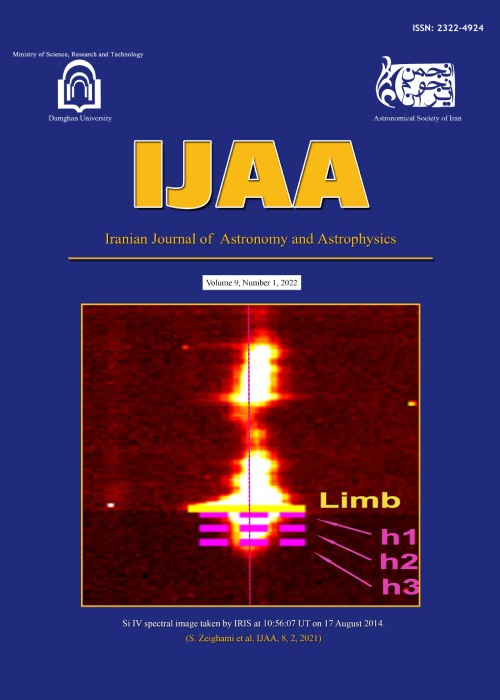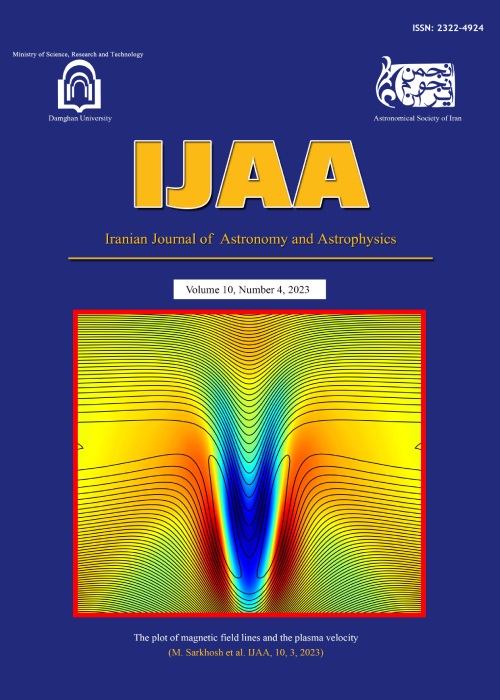فهرست مطالب

Iranian Journal of Astronomy and Astrophysic
Volume:9 Issue: 1, Spring 2022
- تاریخ انتشار: 1402/01/07
- تعداد عناوین: 6
-
-
Pages 1-17Instead of the work cite{1} given by Glaven and Lin in which in according to the Lovelock theorem it is not applicable for all types of 4-dimensional curved spacetimes of Einstein Gauss Bonnet gravity, authors of the work cite{2} applied breakdown of diffeomorphism property to present a consistentEinstein-Gauss-Bonnet gravity theory in 4-dimensions. In this work we use the latter model by adding an Ayon-Beato-Garcia type of nonlinear electromagnetic field Lagrangian density to study effects of Gauss-Bonnet coupling constant on the thermodynamic phase transition and Joule-Thomson adiabatic expansion of a 4-dimensional de Sitter/Anti de Sitter Gauss-Bonnet-Bardeen black hole. In fact we will see importance of parameters of this black hole namely the magnetic charge and the Gauss Bonnet coupling constant parameter on its heating-cooling phase transition. Physical importance of this type of black holes is non-singular property which they have and are applicable to study black hole structure of center of galaxies.Keywords: Non-singular black holes, nonlinear Maxwell fields, Thermodynamic physic transition, Joule Thomson effect, Magnetic charge
-
Pages 19-30
Astronomy is experiencing rapid growth in the size and complexity of data. This reinforces the development of data-driven science as a useful complement to the current model of model-based data analysis. In spite of this, traditional merger analysis of catalogs is mostly done through visual inspection by trained experts. A method that is not efficient today, because the subjectivity of manual classification has made the result of the process very dependent on the intuition of the analyst and the type and quality of the image. Hence, this study focuses on data processing methods based on Artificial Intelligence (AI) algorithms and investigates the possibility of a pattern among astronomical data to predict the merger of galaxies. The modeling is done in two phases. The first phase deals with the classification between minority and majority classes and the second phase search for any distinction between minority classes. In both phases, various algorithms such as Naive Bayes, Random Forest, and Generalized linear model (GLM) and Neural network are used to ensure the best results according to the research data. The best results for both phases obtained from the implementation of the GLM algorithm with the accuracy of 70.28 % and 76.51% for the first and second phase respectively.
Keywords: Galaxy Morphology, Galaxy Merge, Near-Infrared Spectroscopy, Galaxy Zoo, Machine Learning -
Pages 31-44The importance of using fast and automatic methods to classify variable stars for large amounts of data is undeniable. There have been many attempts to classify variable stars by traditional algorithms like Random Forest. In recent years, neural networks as classifiers have come to notice because of their lower computational cost compared to traditional algorithms. This paper uses the Hierarchical Classification technique, which contains two main steps of predicting class and then subclass of stars. All the models in both steps have same network structure and we test both Convolutional Neural Networks (CNN) and Recurrent Neural Networks (RNN). Our pre-processing method uses light curves and period of stars as input data. We consider most of the classes and subclasses of variable stars in OGLE-IV database and show that using Hierarchical Classification technique and designing appropriate preprocessing can increase accuracy of predicting smaller classes, ACep and T2Cep. We obtain an accuracy of 98% for class classification and 93% for subclasses classification.Keywords: Variable Stars, Hierarchical Method, Convolutional Neural Networks
-
Pages 45-57Instead ofscalar-tensor gravitymodels which are applicable fordescription of cosmic inflation with unknown dark sector ofmatter/energy, at present tensethere are presented different alternativescalar-tensor-vector gravitieswhere meaningful dynamical vector fields can support cosmicinflation well without to use dark matter/energy concept. One ofthese gravity models was presented by Moffat whichits modified Schwarzschild black hole solution is used tostudy thermodynamic phase transition in presence of the AdS spacepressure in this article. To doso, we obtained an equation of state which asymptotically reachesto equation of state of ideal gas for large black holes but forsmall scale black holes we obtained a critical point at phasespace where the black hole can beexhibited with a phase transitionat processes ofisothermal andisobaric. By looking at diagrams of the Gibbs free energy and theheat capacity at constant pressure which are plotted versus thetemperature and the specific volume one can see an inflectionpoint which means that the phase transition issecond order type. In fact thereis small to large phase transition for the black hole which isequivalent to the Van der Waals liquid-gas phase transition inordinary thermodynamic systems. The phase transitionhappens below the critical pointin phase space when the gravitational charge of the black hole isequal to its mass.Keywords: Modified Gravity, Thermodynamics of black holes, Schwarzchild, de Sitter, Phase transition
-
Pages 59-83In this study we review solar chromospheric jets and characteristics of them. The chromosphere and transition region are the interface between the solar photosphere and the corona, which plays a key role in the formation and acceleration of the solar wind. In recent years, scientists have made great efforts to understand the mechanism of energy transfer in the solar chromosphere and corona. The researchers suggest that the key to solving this problem may lie in understanding the nature of the small-scale transient events that are distributed across the surface of the Sun. Of these, solar spicules are the most prominent small-scale dynamical phenomena in the chromospheric regions that drive relatively cold material from the lower chromosphere to the corona. Spicules can heat the corona both by ejecting hot plasma and by energy transfer by magnetohydrodynamic (MHD) waves. These dynamical structures are formed when photospheric oscillations and convective flow along the magnetic field lines penetrate into the chromosphere.Keywords: Chromosphere, jets, Spicules, oscillations, Plasma, Image processing
-
Pages 85-96
To investigate the effect of asymmetric magnetic reconnection on the development of the diffusion region and growth of magnetic islands induced during reconnection (plasmoids), we use 2-dimensional resistive magnetohydrodynamics sim- ulations. In particular, we consider the strength of the magnetic field and plasma mass density to be dissimilar on both sides of the current sheet. For three cases, the results show that the initial X-point position shifts from the center of the diffusion region to the stronger magnetic field while the plasmoids grow toward the weaker magnetic field. Also, the increase of asymmetry in the magnetic field and plasma mass density leads to the reconnection rate and the growth time of plasmoid instability becoming less. Due to the displacement of reconnection sites in asymmetric cases, the output momentum from these sites does not directly collide with the outflow jets, so the velocity of the outflow jets is lower than in the symmetric case.
Keywords: Space plasmas, Magnetic reconnection, Plasmoid Instability, MHD simulation


